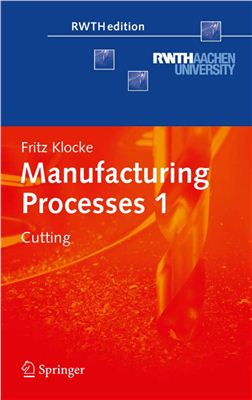Springer-Verlag, Berlin, 2011, 504 pages
The book series on manufacturing processes for engineers is a reference work for scientific and industrial experts. This volume on Tuing, Milling and Drilling starts from the basic principles of machining with geometrically defined cutting edges based on a common active principle. In addition, appropriate tool designs as well as the reasonable use of cutting material are presented. A detailed chapter about the machinability of the most important workpiece materials, such as steel and cast iron, light metal alloys and high temperature resistant materials imparts a broad knowledge of the interrelations between workpiece materials, cutting materials and process parameters.
The structure of the book is oriented to a large extent at didactical criteria. The first section deals with the metrology and the workpiece quality, followed by a chapter about the fundamentals of cutting. Based on the common technological principle of the cutting processes and their variants, the second section deals with the mechanisms occurring at the cutting edge and the resulting loads on the tools. The next section deals with the demands on the cutting materials as well as their manufacturing
processes and application. The text presents topics like the use of the finite element method for cutting processes as well as cutting fluids. A detailed chapter about the machinability of the most important work piece materials, such as steel and cast iron, light metal alloy and high temperature resistant materials imparts a broad knowledge of the alteating coactions of work piece material, the cutting material and the process parameters.
The book series on manufacturing processes for engineers is a reference work for scientific and industrial experts. This volume on Tuing, Milling and Drilling starts from the basic principles of machining with geometrically defined cutting edges based on a common active principle. In addition, appropriate tool designs as well as the reasonable use of cutting material are presented. A detailed chapter about the machinability of the most important workpiece materials, such as steel and cast iron, light metal alloys and high temperature resistant materials imparts a broad knowledge of the interrelations between workpiece materials, cutting materials and process parameters.
The structure of the book is oriented to a large extent at didactical criteria. The first section deals with the metrology and the workpiece quality, followed by a chapter about the fundamentals of cutting. Based on the common technological principle of the cutting processes and their variants, the second section deals with the mechanisms occurring at the cutting edge and the resulting loads on the tools. The next section deals with the demands on the cutting materials as well as their manufacturing
processes and application. The text presents topics like the use of the finite element method for cutting processes as well as cutting fluids. A detailed chapter about the machinability of the most important work piece materials, such as steel and cast iron, light metal alloy and high temperature resistant materials imparts a broad knowledge of the alteating coactions of work piece material, the cutting material and the process parameters.

